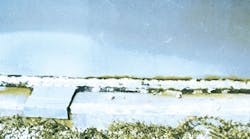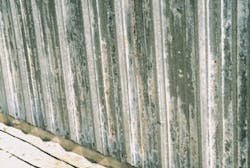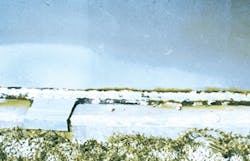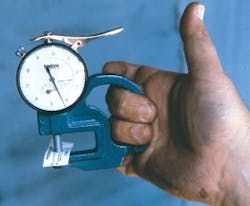How did we get involved with industrial painting? In most cases, we were thrown into it, kicking and screaming. How difficult can it be to paint something? You have your blue paint, red paint and numerous other colors. For most of us, that was how it started. Then, we had a premature coating failure that required repair and it cost lots of money. The painting contractor said the paint was no good and refused to honor the warranty. The surety company sided with the contractor. It’s time to get serious about industrial coatings.
The fact is that we need to get smart. In the 1970s and 1980s, 80% of the premature failures could be attributed to improper application techniques. Based on my years in the failure analysis business, that was a pretty good estimate. The remaining 20% were attributed to material selection, specification errors or omissions, and design configurations that couldn’t be coated or inspected in accordance with the specification. These are termed inaccessible areas.
In the 1980s, organizations such as NACE International and SSPC: The Society for Protective Coatings, initiated training programs for personnel and companies involved in the industrial painting business. The price of labor had risen substantially and the new high-performance coating materials became far more application-critical. The Environmental Protection Agency and the Occupational Safety and Health Administration added to the mix by initiating regulations protecting the public from transient dust and the worker from health hazards. SSPC initiated contractor qualification programs, which required painting applicators to attend many of these training programs.
For the first time, training was available to teach personnel how to inspect the application of protective coatings. In other words, the coating applicators are more technically competent today. They’ve become so out of necessity, and their work has improved. Personnel from applicators commonly attend these training classes. NACE has already certified more than 4,200 coating inspectors. About 20% of these inspectors work for coating applicators.
In the 21st century, the cause of premature failures attributed to coating application has been reduced from 80% to about 40%, and is dropping. This means that 60% of the premature failures are traced to material selection, specification errors or omissions, or design not lending itself to proper coating application or inspection.
How to cause coating problems
This development has meaning for the maintenance engineer responsible for painting in a manufacturing facility. Let’s start by assuming that you don’t have a qualified coating engineer working in your plant. Having one would be nice, but the position of coating engineer in a manufacturing facility is fast disappearing. Let’s explore some of the important actions that frequently cause problems before, during and after a painting project.
Before starting the work, you’ll need to know that coating manufacturers publish technical data sheets, application instructions and material safety data sheets for each product being marketed. A common reason for coating failure is ignoring what the printed forms tell you. If you anticipate that you’ll need to deviate from the guidelines in these publications, contact the coating manufacturer’s technical service department, not the salesman, for guidance. Unilateral deviation from these publications can be risky.
But, be aware that the manufacturer’s data alone isn’t sufficient to accomplish flawless work because the information is general in nature. In addition to the manufacturer’s information, you’ll need a specification that describes the work to be accomplished. The specification should include the manufacturer’s technical information and job-specific information such as material selection options, the scope to be painted, inspection requirements, safety, working hours and the like.
Insist on a pre-job conference to ensure a meeting of the minds between the applicator and the owner. At this meeting, discuss the requirements of the specification and take the applicator on a pre-job walk-through. It’s vital to identify any areas that can’t be coated or inspected in conformance with the specification and decide how they are to be protected. This also is the time to define how the inspection will be conducted and identify the inspectors, responsibilities and authority. It’s recommended that your inspector be an employee or under contract to your plant, not the applicator.
This corrugated galvanized siding is ready for maintenance.
Rough weld at tank baseplate shows evidence of corrosion.
Coating inspectors should be able to measure the anchor pattern/surface roughness.
Minimize disruption
For a manufacturing plant, the most critical aspect of executing the work is coordinating with and protecting adjacent operating areas. This problem can be minimized by selecting alternate surface preparation methods. Using ultra-high-pressure water-jetting (UHPWJ) at pressures higher than 35,000 psi can minimize dust and over-blast problems. Commonly available UHPWJ equipment will remove adherent coatings cleanly to the original anchor pattern. In most cases, it produces a cleaner surface than abrasive blasting because no residual abrasive is embedded in the substrate.
Adding inhibiters to the water can maintain the desired level of cleanliness for a limited period of time. A copy of the standard, SSPC-SP 12/NACE No.5, Surface Preparation and Cleaning of Metals by Water-Jetting Prior to Recoating, describes options to be considered when specifying water jetting.
Monitor to the bitter end
It is important that inspectors work efficiently and promptly. They should be present to observe the operation, report progress to management and document their observations and measurements. Because stop-work authority normally remains a management prerogative, the inspection methodology and frequency, along with prompt reporting, becomes important.
The inspector should work with the coating applicator, but shouldn’t attempt to supervise or direct the work. Establish the mechanism for directing the coating applicator at the pre-job conference — it should involve the project manager of purchasing personnel. Before a job can be considered complete, you’ll need to conduct a rigorous job inspection and prepare a final punch list.
It’s my experience that this step is too often merely a visual inspection made on the basis of a brief walk-through with the contractor, followed up by a letter stating that all is well. This approach is inadequate, considering the money you spent on the project, and it all too frequently results in failures that require repair during the first year.
Punch list items that are repaired should be inspected again to verify adequacy. This might be countered by requiring a warranty from the coating applicator. Warranties sound good, but they’re difficult to enforce, frequently resulting in disagreements about the cause of the failure. A suggested alternative would be to require a one-year inspection and repair contract. This should lead to the coatings performing to their anticipated life.
Pay for an inspector
The plant engineer or maintenance engineer already has a full-time job. Inspecting a coating applicator on a sizable job represents another full-time job. I’ve been involved with coating projects where the in-house engineer attempted the painting inspection in addition to performing the normal assignments. The quality of both the inspection and the project was compromised. The painting contractor is human, like everyone else. There will be errors made that, hopefully, the inspector will recognize and have corrected. The cost of a coating inspector is about equal to adding one painter to the project. It’s well worth the expenditure.
To recap, you should review, read, understand and follow the information published by the coating manufacturer. Prepare a specification for the work. Hold a pre-job conference and address inaccessible areas. Use the services of a qualified coating inspector. Establish an effective communication system. Verify that any deviation from specification has been repaired. Then, enjoy the coating’s anticipated life span.
S.G. Pinney is president of S.G. Pinney, P.E. Inc., providing consulting services and failure analysis to users of industrial coatings. Contact him at [email protected] and (772) 879-0600.
Figures: S.G. Pinney, P.E. Inc.



